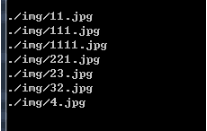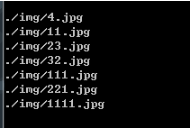python文件排序的方法总结
在python环境中提供两种排序方案:用库函数sorted()对字符串排序,它的对象是字符;用函数sort()对数字排序,它的对象是数字,如果读取文件的话,需要进行处理(把文件后缀名‘屏蔽')。
(1)首先:我测试的文件夹是/img/,里面的文件都是图片,如下图所示:

(2)测试库函数sorted(),直接贴出代码:
import numpy as np import os img_path='./img/' img_list=sorted(os.listdir(img_path))#文件名按字母排序 img_nums=len(img_list) for i in range(img_nums): img_name=img_path+img_list[i] print(img_name)
运行效果如下:

从图片可以清晰的看出,文件名是按字符排序的。
(3)测试函数sort(),代码:
import numpy as np import os img_path='./img/' img_list=os.listdir(img_path) img_list.sort() img_list.sort(key = lambda x: int(x[:-4])) ##文件名按数字排序 img_nums=len(img_list) for i in range(img_nums): img_name=img_path+img_list[i] print(img_name)
运行效果如下:

可以看出,文件名是按数字排序的;顺便提下,sort函数中用到了匿名函数(key = lambda x:int(x[:-4])),其作用是将后缀名'.jpg'“屏蔽”(因为‘.jpg'是4个字符,所以[:-4]的含义是从文件名开始到倒数第四个字符为止),具体看python的匿名函数和数组取值方式。
实例扩展:
import gzip
import os
from multiprocessing import Process, Queue, Pipe, current_process, freeze_support
from datetime import datetime
def sort_worker(input,output):
while True:
lines = input.get().splitlines()
element_set = {}
for line in lines:
if line.strip() == 'STOP':
return
try:
element = line.split(' ')[0]
if not element_set.get(element): element_set[element] = ''
except:
pass
sorted_element = sorted(element_set)
#print sorted_element
output.put('\n'.join(sorted_element))
def write_worker(input, pre):
os.system('mkdir %s'%pre)
i = 0
while True:
content = input.get()
if content.strip() == 'STOP':
return
write_sorted_bulk(content, '%s/%s'%(pre, i))
i += 1
def write_sorted_bulk(content, filename):
f = file(filename, 'w')
f.write(content)
f.close()
def split_sort_file(filename, num_sort = 3, buf_size = 65536*64*4):
t = datetime.now()
pre, ext = os.path.splitext(filename)
if ext == '.gz':
file_file = gzip.open(filename, 'rb')
else:
file_file = open(filename)
bulk_queue = Queue(10)
sorted_queue = Queue(10)
NUM_SORT = num_sort
sort_worker_pool = []
for i in range(NUM_SORT):
sort_worker_pool.append( Process(target=sort_worker, args=(bulk_queue, sorted_queue)) )
sort_worker_pool[i].start()
NUM_WRITE = 1
write_worker_pool = []
for i in range(NUM_WRITE):
write_worker_pool.append( Process(target=write_worker, args=(sorted_queue, pre)) )
write_worker_pool[i].start()
buf = file_file.read(buf_size)
sorted_count = 0
while len(buf):
end_line = buf.rfind('\n')
#print buf[:end_line+1]
bulk_queue.put(buf[:end_line+1])
sorted_count += 1
if end_line != -1:
buf = buf[end_line+1:] + file_file.read(buf_size)
else:
buf = file_file.read(buf_size)
for i in range(NUM_SORT):
bulk_queue.put('STOP')
for i in range(NUM_SORT):
sort_worker_pool[i].join()
for i in range(NUM_WRITE):
sorted_queue.put('STOP')
for i in range(NUM_WRITE):
write_worker_pool[i].join()
print 'elasped ', datetime.now() - t
return sorted_count
from heapq import heappush, heappop
from datetime import datetime
from multiprocessing import Process, Queue, Pipe, current_process, freeze_support
import os
class file_heap:
def __init__(self, dir, idx = 0, count = 1):
files = os.listdir(dir)
self.heap = []
self.files = {}
self.bulks = {}
self.pre_element = None
for i in range(len(files)):
file = files[i]
if hash(file) % count != idx: continue
input = open(os.path.join(dir, file))
self.files[i] = input
self.bulks[i] = ''
heappush(self.heap, (self.get_next_element_buffered(i), i))
def get_next_element_buffered(self, i):
if len(self.bulks[i]) < 256:
if self.files[i] is not None:
buf = self.files[i].read(65536)
if buf:
self.bulks[i] += buf
else:
self.files[i].close()
self.files[i] = None
end_line = self.bulks[i].find('\n')
if end_line == -1:
end_line = len(self.bulks[i])
element = self.bulks[i][:end_line]
self.bulks[i] = self.bulks[i][end_line+1:]
return element
def poppush_uniq(self):
while True:
element = self.poppush()
if element is None:
return None
if element != self.pre_element:
self.pre_element = element
return element
def poppush(self):
try:
element, index = heappop(self.heap)
except IndexError:
return None
new_element = self.get_next_element_buffered(index)
if new_element:
heappush(self.heap, (new_element, index))
return element
def heappoppush(dir, queue, idx = 0, count = 1):
heap = file_heap(dir, idx, count)
while True:
d = heap.poppush_uniq()
queue.put(d)
if d is None: return
def heappoppush2(dir, queue, count = 1):
heap = []
procs = []
queues = []
pre_element = None
for i in range(count):
q = Queue(1024)
q_buf = queue_buffer(q)
queues.append(q_buf)
p = Process(target=heappoppush, args=(dir, q_buf, i, count))
procs.append(p)
p.start()
queues = tuple(queues)
for i in range(count):
heappush(heap, (queues[i].get(), i))
while True:
try:
d, i= heappop(heap)
except IndexError:
queue.put(None)
for p in procs:
p.join()
return
else:
if d is not None:
heappush(heap,(queues[i].get(), i))
if d != pre_element:
pre_element = d
queue.put(d)
def merge_file(dir):
heap = file_heap( dir )
os.system('rm -f '+dir+'.merge')
fmerge = open(dir+'.merge', 'a')
element = heap.poppush_uniq()
fmerge.write(element+'\n')
while element is not None:
element = heap.poppush_uniq()
fmerge.write(element+'\n')
class queue_buffer:
def __init__(self, queue):
self.q = queue
self.rbuf = []
self.wbuf = []
def get(self):
if len(self.rbuf) == 0:
self.rbuf = self.q.get()
r = self.rbuf[0]
del self.rbuf[0]
return r
def put(self, d):
self.wbuf.append(d)
if d is None or len(self.wbuf) > 1024:
self.q.put(self.wbuf)
self.wbuf = []
def diff_file(file_old, file_new, file_diff, buf = 268435456):
print 'buffer size', buf
from file_split import split_sort_file
os.system('rm -rf '+ os.path.splitext(file_old)[0] )
os.system('rm -rf '+ os.path.splitext(file_new)[0] )
t = datetime.now()
split_sort_file(file_old,5,buf)
split_sort_file(file_new,5,buf)
print 'split elasped ', datetime.now() - t
os.system('cat %s/* | wc -l'%os.path.splitext(file_old)[0])
os.system('cat %s/* | wc -l'%os.path.splitext(file_new)[0])
os.system('rm -f '+file_diff)
t = datetime.now()
zdiff = open(file_diff, 'a')
old_q = Queue(1024)
new_q = Queue(1024)
old_queue = queue_buffer(old_q)
new_queue = queue_buffer(new_q)
h1 = Process(target=heappoppush2, args=(os.path.splitext(file_old)[0], old_queue, 3))
h2 = Process(target=heappoppush2, args=(os.path.splitext(file_new)[0], new_queue, 3))
h1.start(), h2.start()
old = old_queue.get()
new = new_queue.get()
old_count, new_count = 0, 0
while old is not None or new is not None:
if old > new or old is None:
zdiff.write('< '+new+'\n')
new = new_queue.get()
new_count +=1
elif old < new or new is None:
zdiff.write('> '+old+'\n')
old = old_queue.get()
old_count +=1
else:
old = old_queue.get()
new = new_queue.get()
print 'new_count:', new_count
print 'old_count:', old_count
print 'diff elasped ', datetime.now() - t
h1.join(), h2.join()
到此这篇关于python文件排序的方法总结的文章就介绍到这了,更多相关python文件排序都有哪些方法内容请搜索脚本之家以前的文章或继续浏览下面的相关文章希望大家以后多多支持脚本之家!
相关文章

python中split(), os.path.split()和os.path.splitext()的用法
本文主要介绍了python中split(), os.path.split()和os.path.splitext()的用法,文中通过示例代码介绍的非常详细,对大家的学习或者工作具有一定的参考学习价值,需要的朋友们下面随着小编来一起学习学习吧2023-02-02
django利用request id便于定位及给日志加上request_id
这篇文章主要介绍了django利用request id便于定位及给日志加上request_id的相关资料,文中通过示例代码介绍的非常详细,对大家学习或者使用django具有一定的参考学习价值,需要的朋友们下面来一起看看吧2018-08-08












最新评论